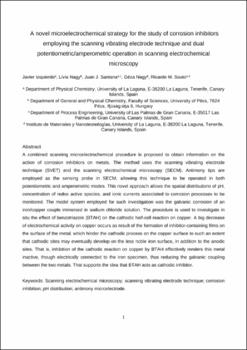A novel microelectrochemical strategy for the study of corrosion inhibitors employing the scanning vibrating electrode technique and dual potentiometric/amperometric operation in scanning electrochemical microscopy: Application to the study of the cathodic inhibition by benzotriazole of the galvanic corrosion of copper coupled to iron
Fecha
2011Resumen
A combined scanning microelectrochemical procedure is proposed to obtain information on the action of corrosion inhibitors on metals. The method uses the scanning vibrating electrode technique (SVET) and the scanning electrochemical microscopy (SECM). Antimony tips are employed as the sensing probe in SECM, allowing this technique to be operated in both potentiometric and amperometric modes. This novel approach allows the spatial distributions of pH, concentration of redox active species, and ionic currents associated to corrosion processes to be monitored. The model system employed for such investigation was the galvanic corrosion of an iron/copper couple immersed in sodium chloride solution. The procedure is used to investigate in situ the effect of benzotriazole (BTAH) on the cathodic half-cell reaction on copper. A big decrease of electrochemical activity on copper occurs as result of the formation of inhibitor-containing films on the surface of the metal, which hinder the cathodic process on the copper surface to such an extent that cathodic sites may eventually develop on the less noble iron surface, in addition to the anodic sites. That is, inhibition of the cathodic reaction on copper by BTAH effectively renders this metal inactive, though electrically connected to the iron specimen, thus reducing the galvanic coupling between the two metals. That supports the idea that BTAH acts as cathodic inhibitor






